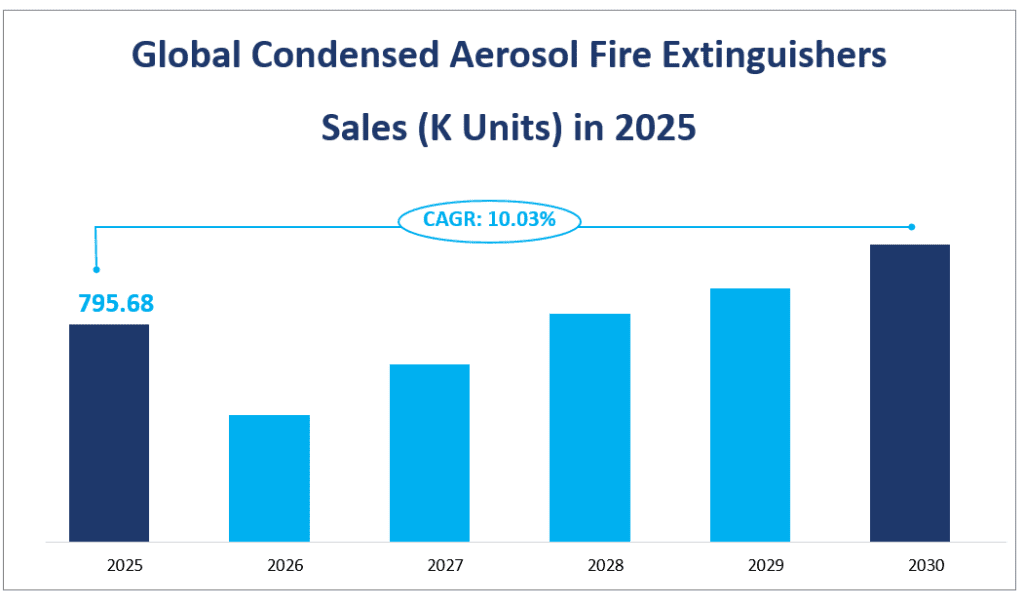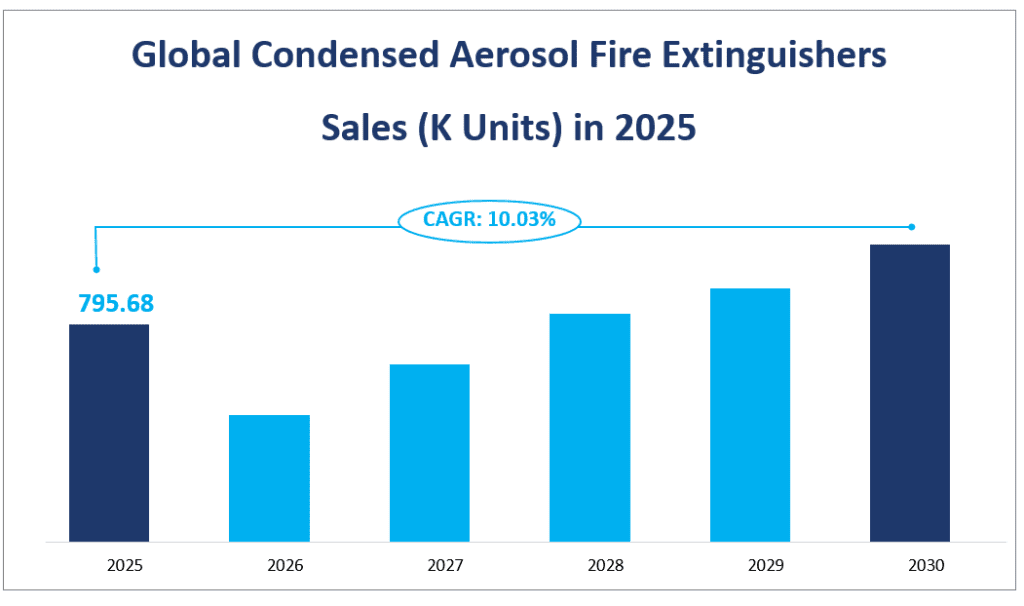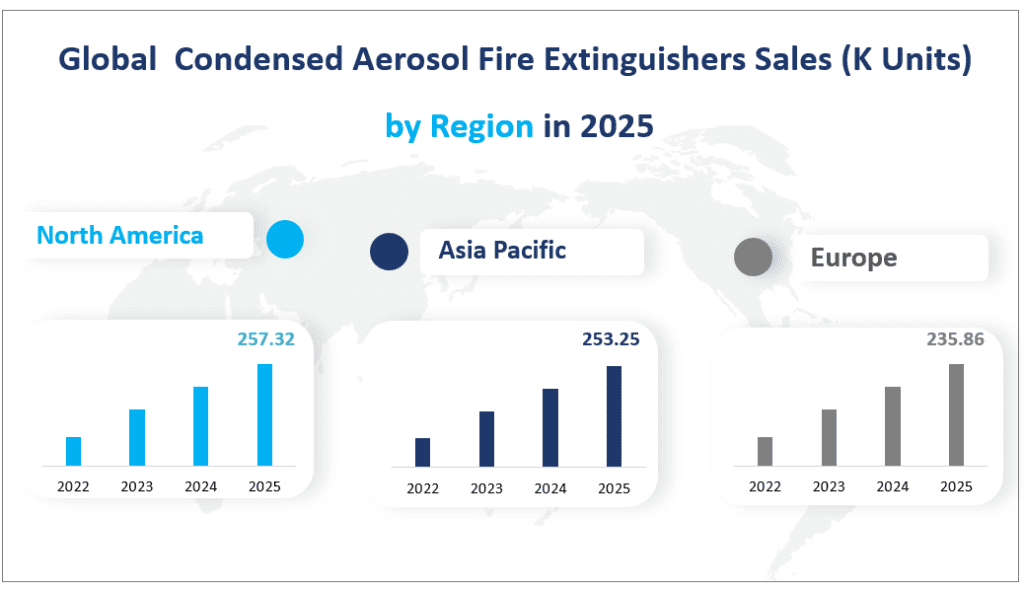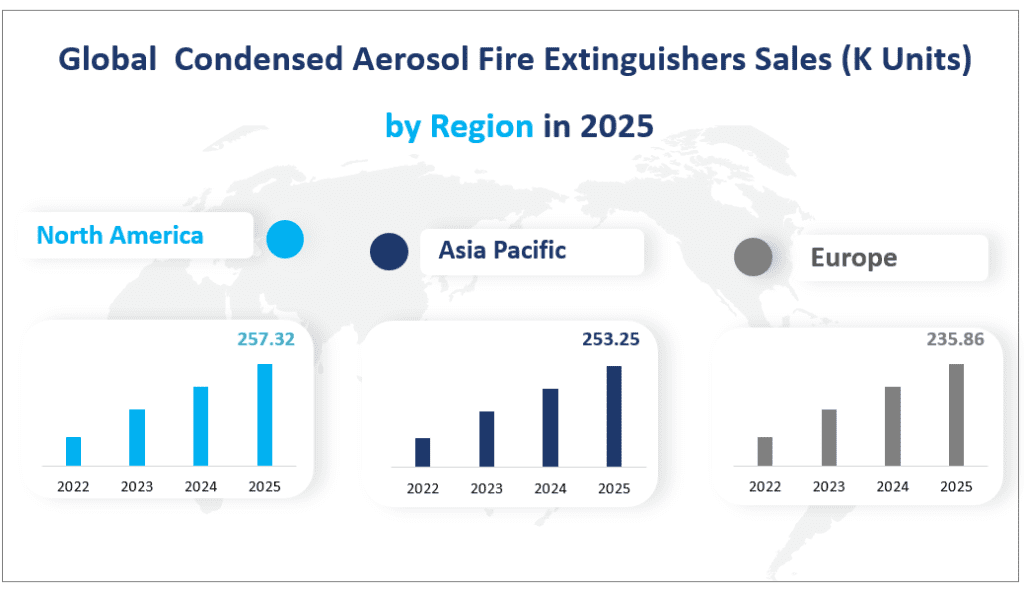1. Global Condensed Aerosol Fire Extinguishers Market Sales and CAGR Analysis
The global condensed aerosol fire extinguishers market sales will be 795.68 K Units in 2025, showcasing a robust compound annual growth rate (CAGR) of 10.03% from 2025 to 2030. This growth is attributed to the increasing demand for advanced fire safety solutions across various industries, including manufacturing, transportation, and nuclear power.
A condensed aerosol fire extinguisher is a sophisticated fire suppression device that utilizes a fine mixture of solid particles and gaseous substances to extinguish fires. When activated, these systems produce a uniform aerosol that suppresses flames effectively. They are particularly effective in enclosed spaces and are known for their minimal residue post-extinguishing, making them ideal for use in sensitive equipment areas and high-risk industries. The market is segmented by type, with K Type Aerosol Fire Extinguishers leading the sales, and by application, covering a broad spectrum including the nuclear power industry.
The condensed aerosol fire extinguishers market’s growth is influenced by several factors, including the need for more efficient and environmentally friendly fire suppression solutions, the increasing awareness of fire safety, and the strict regulations enforcing the use of advanced fire extinguishing systems in various sectors. The CAGR for the next few years indicates a steady increase in the adoption of condensed aerosol fire extinguishers, reflecting the market’s potential and the growing reliance on these systems for effective fire management.
Global Condensed Aerosol Fire Extinguishers Sales (K Units) in 2025


2. Driving Factors of Condensed Aerosol Fire Extinguishers Market
The growth of the condensed aerosol fire extinguishers market is propelled by several driving factors. Firstly, the increasing emphasis on fire safety and the subsequent rise in the adoption of advanced fire suppression systems is a key driver. As industries become more aware of the potential risks and damages caused by fires, the demand for reliable and efficient fire extinguishing solutions soars.
Secondly, the technological advancements in fire suppression technology have made condensed aerosol fire extinguishers more effective and environmentally friendly. These systems do not deplete oxygen levels, are harmless to humans and animals, and do not cause overpressure, making them a preferred choice in many applications.
Thirdly, the global trend towards digital transformation and the integration of the Internet, cloud computing, and big data technologies have influenced the fire suppression industry. The COVID-19 pandemic has accelerated this transformation, prompting businesses to adopt digital solutions and driving the development of smarter, more technologically advanced fire extinguishers.
3. Limiting Factors of Condensed Aerosol Fire Extinguishers Market
However, the market’s growth is not without challenges. Strict regulations and the high costs associated with research and development and compliance can limit the market’s growth. Additionally, the market faces competition from other fire suppression systems, which may be more cost-effective in certain applications. The maturity of the product and the design and calculation challenges of the pipe network system also present barriers to the widespread adoption of condensed aerosol fire extinguishers.
In conclusion, while the condensed aerosol fire extinguishers market is expected to grow significantly in the coming years, it must navigate through a complex landscape of opportunities and challenges. The market’s success will depend on its ability to innovate, comply with regulations, and meet the evolving needs of a digitally transforming world.
4. Global Condensed Aerosol Fire Extinguishers Market Segment
Product Types Analysis
The global condensed aerosol fire extinguishers market is diversifying, with two primary product types leading the industry: K Type Aerosol Fire Extinguisher and S Type Aerosol Fire Extinguisher. Each type is defined by its chemical composition and application suitability, catering to different fire suppression needs.
K Type Aerosol Fire Extinguisher: This type, also known as potassium salt fire extinguishing technology, was developed in the mid-1960s and primarily uses potassium nitrate as the oxidant. K Type extinguishers are designed for fires involving flammable liquids, oils, and fats. However, due to the formation of a conductive liquid film that can damage electronic equipment, their use is limited in such environments. Despite this, the K Type is projected to have the largest market share in 2025, with sales reaching 695.30 K Units, reflecting its widespread adoption in suitable applications.
S Type Aerosol Fire Extinguisher: Representing the third generation of aerosol technology, S Type extinguishers use strontium salts as the main oxidant. Unlike K Type, strontium ions do not absorb moisture, form conductive solutions, or damage electrical equipment, making them suitable for enclosed spaces like electrical cabinets and engine rooms. In 2025, the S Type is expected to achieve sales of 100.38 K Units, indicating a growing market presence.
When comparing the growth rates, the S Type exhibits a faster growth trajectory. This suggests that while the K Type maintains a larger market share, the S Type is gaining ground rapidly, driven by its safety in electronic environments and the increasing demand for non-conductive fire suppression solutions.
Applications Analysis
The applications of condensed aerosol fire extinguishers are broad, spanning across various industries. The market is segmented into manufacturing and processing, transportation and logistics, nuclear power, energy, commercial, and others. Each application has unique requirements that condensed aerosol fire extinguishers are designed to meet.
Manufacturing and Processing Industry: This sector accounts for the largest market share, with sales projected to reach 133.08 K Units in 2025, reflecting the established need for fire safety in production environments.
Transportation and Logistics Industry: With sales expected to hit 157.92 K Units, indicating significant demand for fire safety measures in vehicles and transportation infrastructure.
Nuclear Power Industry: This high-risk industry demands the highest standards for fire-extinguishing tools. The nuclear power application is projected to have sales of 53.86 K Units in 2025, making it one of the fastest-growing applications
Energy Industry: Wind turbines and other energy conversion equipment are prone to fires, necessitating reliable fire suppression. The energy industry is expected to reach 198.63 K Units in sales.
Commercial Application: Covering a wide range of buildings and facilities, the commercial sector is projected to have sales reaching 139.38 K Units in 2025, highlighting the increasing need for fire safety in urban and commercial development.
Others: This category includes various other applications and is expected to have sales of 122.96 K Units.
In conclusion, the global condensed aerosol fire extinguishers market is characterized by a diverse range of product types and applications, each with its market dynamics. The K Type holds the largest market share, while the S Type shows the fastest growth rate. Similarly, the commercial sector is expected to have the fastest growth in terms of application, with the nuclear power industry also showing significant expansion. As the market evolves, it is clear that technological advancements, increased safety regulations, and the need for more efficient fire suppression solutions are driving the growth and development of this industry.
Market Sales by Segment
| Market Sales (K Units) in 2025 | ||
| By Type | K Type Aerosol Fire Extinguisher | 695.30 |
| S Type Aerosol Fire Extinguisher | 9.72% | |
| By Application | Manufacturing and Processing Industry | 133.08 |
| Transportation and Logistics Industry | 157.92 | |
| Nuclear Power Industry | 53.86 | |
| Energy Industry | 198.63 | |
| Commercial | 139.38 |
5. Regional Condensed Aerosol Fire Extinguishers Market
The global condensed aerosol fire extinguishers market is a diverse and dynamic landscape, with different regions contributing significantly to the overall market sales.
North America: North America has consistently been a significant contributor to the global condensed aerosol fire extinguishers market. In 2025, the region is projected to lead in terms of sales, with an expected 257.32 K Units. This dominance can be attributed to the region’s strong emphasis on safety regulations, advanced technological adoption, and the presence of major players in the fire suppression industry. The United States, in particular, accounts for a substantial portion of the North American market due to its large industrial base and stringent fire safety standards.
Europe: Europe follows closely behind North America, with an expected sales volume of 235.86 K Units in 2025. The region’s market is driven by a strong focus on environmental safety and the adoption of sustainable fire suppression technologies. Countries like Germany, the UK, and France contribute significantly to the regional market, with their industrial sectors demanding high standards of fire safety.
Asia Pacific: The Asia Pacific region is set to be the fastest-growing market, with a projected sales volume of 253.25 K Units in 2025. The region’s rapid industrialization and urbanization, particularly in countries like China, India, and South Korea, have led to an increased demand for advanced fire safety solutions. The growing awareness of fire safety and the need for modern fire suppression systems in both commercial and industrial sectors are key factors contributing to this growth.
Latin America: Latin America is expected to have sales of 26.18 K Units in 2025, with a moderate growth rate. The region’s market is influenced by countries like Brazil and Mexico, which are experiencing industrial growth and are increasingly adopting advanced fire suppression technologies. The region’s growth is also supported by the need for improved fire safety measures in response to increasing industrial activities.
Middle East & Africa: The Middle East & Africa region is projected to have sales of 23.07 K Units in 2025. While this is a smaller market compared to other regions, it is expected to grow steadily, driven by the oil and gas industry’s demand for advanced fire suppression systems and the increasing focus on safety in the construction and commercial sectors.
In conclusion, the North American market is anticipated to be the largest by sales in 2025, driven by its established industrial base and stringent safety regulations. However, the Asia Pacific region stands out as the fastest-growing market, with its rapid industrialization and increasing demand for advanced fire safety solutions. The regional differences in market size and growth rates are influenced by factors such as economic development, industrialization, safety regulations, and technological advancements. As the global market for condensed aerosol fire extinguishers continues to evolve, understanding these regional dynamics is crucial for stakeholders to make informed strategic decisions and capitalize on emerging opportunities.
Global Condensed Aerosol Fire Extinguishers Sales (K Units) by Region in 2025


6. Top Five Companies in the Condensed Aerosol Fire Extinguishers Market
FirePro (Halma): Established in 1992 and headquartered in Cyprus, FirePro is a leading brand in condensed aerosol fire extinguishing technology. FirePro offers a range of products, including the FP-20T and FP-20TH models, which are known for their compact design, efficiency, and long lifespan. FirePro’s products are used in various applications and industries, providing effective fire suppression solutions.
Fireaway: Founded in 2005 and based in the USA, Fireaway is known for its Stat-X® fire suppression systems. These systems are recognized for their ability to suppress fires quickly and provide reflash protection. Fireaway’s products are suitable for a broad range of applications, including enclosed spaces and special hazard areas.
DSPA: Established in 1987 and headquartered in the Netherlands, DSPA is a leading manufacturer of innovative aerosol generators for fire extinguishing and suppression. DSPA’s products are ecologically safe, non-toxic, and do not deplete oxygen levels, making them an environmentally friendly choice for fire suppression.
RSL Fire: Founded in 2003 and based in Switzerland, RSL Fire offers a wide range of automatic extinguishing systems and aerosol fire extinguishers. RSL Fire’s products are known for their effectiveness in fire suppression, prevention of re-ignition, and eco-friendly nature. They cater to diverse applications, including buses, trains, boats, control cabinets, and wind turbines.
Pyrogen: Established in 1999 and headquartered in Indonesia, Pyrogen is a pioneer in aerosol fire suppression systems. Pyrogen offers the Pyrogen EXA and EXA-M systems, which are non-compressed, non-toxic, and environmentally friendly. These systems are designed for harsh environments and heavy-duty applications, providing quick response and easy maintenance.
Major Players
| Company Name | Headquarters |
| FirePro (Halma) | Cyprus |
| Fireaway | USA |
| DSPA | Netherlands |
| RSL Fire | Switzerland |
| Pyrogen | Indonesia |
| Salamandra Safety | Russia |
| GreenEx Fire Suppression Solutions | Netherlands |
| Amerex Corporation | USA |
| HAFEX | Türkiye |
| Aware Fire Technology | China |
| Firecom Automotive | Italy |
| Lianzhongan Fire Protection Technology | China |
| Jiandun Fire Technology | China |
1. Condensed Aerosol Fire Extinguishers Market Analysis
1.1 Global Condensed Aerosol Fire Extinguishers Market Size and Growth Rate (2018-2025)
1.2 Global Condensed Aerosol Fire Extinguishers Price and Growth Rate (2018-2025)
1.3 Condensed Aerosol Fire Extinguishers Market Trends Analysis
1.4 Global Condensed Aerosol Fire Extinguishers Sales, Revenue and Growth Rate by Downstream Industry 2018-2025
1.5 Global Condensed Aerosol Fire Extinguishers Sales, Revenue and Growth Rate by Region 2018-2025
2. Market Definition and Statistical Scope
2.1 Objective of the Study
2.2 Condensed Aerosol Fire Extinguishers Market Definition
2.3 Market Scope
2.3.1 Market Segmentation by Type, Downstream Industry and Marketing Channel
2.3.2 Major Geographies Covered (North America, Europe, Asia Pacific, Middle East & Africa, Latin America)
2.4 Years Considered for the Study (2018-2029)
2.5 Currency Considered (U.S. Dollar)
2.6 Stakeholders
3. Key Companies’ Profile
3.1 Competitive Profile
3.1.1 Global Condensed Aerosol Fire Extinguishers Sales and Market Share by Companies
3.1.2 Global Condensed Aerosol Fire Extinguishers Revenue and Market Share by Companies
3.2 FirePro (Halma)
3.2.1 Brief Introduction of FirePro (Halma)
3.2.2 FirePro (Halma) Sales, Growth Rate and Global Market Share from 2018-2023
3.2.3 FirePro (Halma) Related Products/Service Introduction
3.2.4 FirePro (Halma) Business Overview/Recent Development/Acquisitions
3.3 Fireaway
3.3.1 Brief Introduction of Fireaway
3.3.2 Fireaway Sales, Growth Rate and Global Market Share from 2018-2023
3.3.3 Fireaway Related Products/Service Introduction
3.3.4 Fireaway Business Overview/Recent Development/Acquisitions
3.4 DSPA
3.4.1 Brief Introduction of DSPA
3.4.2 DSPA Sales, Growth Rate and Global Market Share from 2018-2023
3.4.3 DSPA Related Products/Service Introduction
3.4.4 DSPA Business Overview/Recent Development/Acquisitions
3.5 RSL Fire
3.5.1 Brief Introduction of RSL Fire
3.5.2 RSL Fire Sales, Growth Rate and Global Market Share from 2018-2023
3.5.3 RSL Fire Related Products/Service Introduction
3.5.4 RSL Fire Business Overview/Recent Development/Acquisitions
3.6 Pyrogen
3.6.1 Brief Introduction of Pyrogen
3.6.2 Pyrogen Sales, Growth Rate and Global Market Share from 2018-2023
3.6.3 Pyrogen Related Products/Service Introduction
3.6.4 Pyrogen Business Overview/Recent Development/Acquisitions
3.7 Salamandra Safety
3.7.1 Brief Introduction of Salamandra Safety
3.7.2 Salamandra Safety Sales, Growth Rate and Global Market Share from 2018-2023
3.7.3 Salamandra Safety Related Products/Service Introduction
3.7.4 Salamandra Safety Business Overview/Recent Development/Acquisitions
3.8 GreenEx Fire Suppression Solutions
3.8.1 Brief Introduction of GreenEx Fire Suppression Solutions
3.8.2 GreenEx Fire Suppression Solutions Sales, Growth Rate and Global Market Share from 2018-2023
3.8.3 GreenEx Fire Suppression Solutions Related Products/Service Introduction
3.8.4 GreenEx Fire Suppression Solutions Business Overview/Recent Development/Acquisitions
3.9 Amerex Corporation
3.9.1 Brief Introduction of Amerex Corporation
3.9.2 Amerex Corporation Sales, Growth Rate and Global Market Share from 2018-2023
3.9.3 Amerex Corporation Related Products/Service Introduction
3.9.4 Amerex Corporation Business Overview/Recent Development/Acquisitions
3.10 HAFEX
3.10.1 Brief Introduction of HAFEX
3.10.2 HAFEX Sales, Growth Rate and Global Market Share from 2018-2023
3.10.3 HAFEX Related Products/Service Introduction
3.10.4 HAFEX Business Overview/Recent Development/Acquisitions
3.11 Aware Fire Technology
3.11.1 Brief Introduction of Aware Fire Technology
3.11.2 Aware Fire Technology Sales, Growth Rate and Global Market Share from 2018-2023
3.11.3 Aware Fire Technology Related Products/Service Introduction
3.11.4 Aware Fire Technology Business Overview/Recent Development/Acquisitions
3.12 Firecom Automotive
3.12.1 Brief Introduction of Firecom Automotive
3.12.2 Firecom Automotive Sales, Growth Rate and Global Market Share from 2018-2023
3.12.3 Firecom Automotive Related Products/Service Introduction
3.12.4 Firecom Automotive Business Overview/Recent Development/Acquisitions
3.13 Lianzhongan Fire Protection Technology
3.13.1 Brief Introduction of Lianzhongan Fire Protection Technology
3.13.2 Lianzhongan Fire Protection Technology Sales, Growth Rate and Global Market Share from 2018-2023
3.13.3 Lianzhongan Fire Protection Technology Related Products/Service Introduction
3.13.4 Lianzhongan Fire Protection Technology Business Overview/Recent Development/Acquisitions
3.14 Jiandun Fire Technology
3.14.1 Brief Introduction of Jiandun Fire Technology
3.14.2 Jiandun Fire Technology Sales, Growth Rate and Global Market Share from 2018-2023
3.14.3 Jiandun Fire Technology Related Products/Service Introduction
3.14.4 Jiandun Fire Technology Business Overview/Recent Development/Acquisitions
4. Global Condensed Aerosol Fire Extinguishers Market Segmented by Type
4.1 Global Condensed Aerosol Fire Extinguishers Sales, Revenue and Growth Rate by Type 2018-2023
4.2 K Type Aerosol Fire Extinguisher
4.3 S Type Aerosol Fire Extinguisher
5. Global Condensed Aerosol Fire Extinguishers Market Segmented by Downstream Industry
5.1 Global Condensed Aerosol Fire Extinguishers Sales, Revenue and Growth Rate by Downstream Industry 2018-2023
5.2 Manufacturing and Processing Industry
5.3 Transportation and Logistics Industry
5.4 Nuclear Power Industry
5.5 Energy Industry
5.6 Commercial
6. Condensed Aerosol Fire Extinguishers Industry Chain Analysis
6.1 Value Chain Status
6.2 Upstream Raw Material Analysis
6.3 Midstream Major Company Analysis (by Headquarter)
6.4 Distributors/Traders
6.5 Downstream Major Customer Analysis (by Region)
6.6 Value Chain Under Regional Conflicts
7. The Development and Dynamics of Condensed Aerosol Fire Extinguishers Market
7.1 Driving Factors of the Market
7.2 Factors Challenging the Market
7.3 Opportunities of the Global Condensed Aerosol Fire Extinguishers Market
7.4 Technology Status and Developments in the Condensed Aerosol Fire Extinguishers Market
7.5 Industry News
7.6 Market Investment Scenario Strategic Recommendations
7.7 COVID-19 Impact on Condensed Aerosol Fire Extinguishers Industry
7.8 Industry SWOT Analysis
8 Global Condensed Aerosol Fire Extinguishers Market Segmented by Geography
8.1 Global Condensed Aerosol Fire Extinguishers Revenue and Market Share by Region 2018-2023
8.2 Global Condensed Aerosol Fire Extinguishers Sales and Market Share by Region 2018-2023
9. North America
9.1 North America Condensed Aerosol Fire Extinguishers Sales, Price, Revenue, Gross Margin (%) and Gross Analysis from 2018-2023
9.2 North America Condensed Aerosol Fire Extinguishers Sales Analysis from 2018-2023
9.3 North America Condensed Aerosol Fire Extinguishers Market by Country
9.3.1 North America Condensed Aerosol Fire Extinguishers Sales by Country (2018-2023)
9.3.2 North America Condensed Aerosol Fire Extinguishers Revenue by Country (2018-2023)
9.3.3 United States Condensed Aerosol Fire Extinguishers Sales and Growth (2018-2023)
9.3.4 Canada Condensed Aerosol Fire Extinguishers Sales and Growth (2018-2023)
10 Europe
10.1 Europe Condensed Aerosol Fire Extinguishers Sales, Price, Revenue, Gross Margin (%) and Gross Analysis from 2018-2023
10.2 Europe Condensed Aerosol Fire Extinguishers Sales Analysis from 2018-2023
10.3 Europe Condensed Aerosol Fire Extinguishers Market by Country
10.3.1 Europe Condensed Aerosol Fire Extinguishers Sales by Country (2018-2023)
10.3.2 Europe Condensed Aerosol Fire Extinguishers Revenue by Country (2018-2023)
10.3.3 Germany Condensed Aerosol Fire Extinguishers Sales and Growth (2018-2023)
10.3.4 UK Condensed Aerosol Fire Extinguishers Sales and Growth (2018-2023)
10.3.5 France Condensed Aerosol Fire Extinguishers Sales and Growth (2018-2023)
10.3.6 Italy Condensed Aerosol Fire Extinguishers Sales and Growth (2018-2023)
10.3.7 Spain Condensed Aerosol Fire Extinguishers Sales and Growth (2018-2023)
10.3.8 Russia Condensed Aerosol Fire Extinguishers Sales and Growth (2018-2023)
10.3.9 Netherlands Condensed Aerosol Fire Extinguishers Sales and Growth (2018-2023)
10.3.10 Turkey Condensed Aerosol Fire Extinguishers Sales and Growth (2018-2023)
10.3.11 Switzerland Condensed Aerosol Fire Extinguishers Sales and Growth (2018-2023)
10.3.12 Sweden Condensed Aerosol Fire Extinguishers Sales and Growth (2018-2023)
11 Asia Pacific
11.1 Asia Pacific Condensed Aerosol Fire Extinguishers Sales, Price, Revenue, Gross Margin (%) and Gross Analysis from 2018-2023
11.2 Asia Pacific Condensed Aerosol Fire Extinguishers Sales Analysis from 2018-2023
11.3 Asia Pacific Condensed Aerosol Fire Extinguishers Market by Country
11.3.1 Asia Pacific Condensed Aerosol Fire Extinguishers Sales by Country (2018-2023)
11.3.2 Asia Pacific Condensed Aerosol Fire Extinguishers Revenue by Country (2018-2023)
11.3.3 China Condensed Aerosol Fire Extinguishers Sales and Growth (2018-2023)
11.3.4 Japan Condensed Aerosol Fire Extinguishers Sales and Growth (2018-2023)
11.3.5 South Korea Condensed Aerosol Fire Extinguishers Sales and Growth (2018-2023)
11.3.6 Australia Condensed Aerosol Fire Extinguishers Sales and Growth (2018-2023)
11.3.7 India Condensed Aerosol Fire Extinguishers Sales and Growth (2018-2023)
11.3.8 Indonesia Condensed Aerosol Fire Extinguishers Sales and Growth (2018-2023)
11.3.9 Philippines Condensed Aerosol Fire Extinguishers Sales and Growth (2018-2023)
11.3.10 Malaysia Condensed Aerosol Fire Extinguishers Sales and Growth (2018-2023)
12 Latin America
12.1 Latin America Condensed Aerosol Fire Extinguishers Sales, Price, Revenue, Gross Margin (%) and Gross Analysis from 2018-2023
12.2 Latin America Condensed Aerosol Fire Extinguishers Sales Analysis from 2018-2023
12.3 Latin America Condensed Aerosol Fire Extinguishers Market by Country
12.3.1 Latin America Condensed Aerosol Fire Extinguishers Sales by Country (2018-2023)
12.3.2 Latin America Condensed Aerosol Fire Extinguishers Revenue by Country (2018-2023)
12.3.3 Brazil Condensed Aerosol Fire Extinguishers Sales and Growth (2018-2023)
12.3.4 Mexico Condensed Aerosol Fire Extinguishers Sales and Growth (2018-2023)
12.3.5 Argentina Condensed Aerosol Fire Extinguishers Sales and Growth (2018-2023)
13. Middle East & Africa
13.1 Middle East & Africa Condensed Aerosol Fire Extinguishers Sales, Price, Revenue, Gross Margin (%) and Gross Analysis from 2018-2023
13.2 Middle East & Africa Condensed Aerosol Fire Extinguishers Sales Analysis from 2018-2023
13.3 Middle East & Africa Condensed Aerosol Fire Extinguishers Market by Country
13.3.1 Middle East & Africa Condensed Aerosol Fire Extinguishers Sales by Country (2018-2023)
13.3.2 Middle East & Africa Condensed Aerosol Fire Extinguishers Revenue by Country (2018-2023)
13.3.3 Saudi Arabia Condensed Aerosol Fire Extinguishers Sales and Growth (2018-2023)
13.3.4 UAE Condensed Aerosol Fire Extinguishers Sales and Growth (2018-2023)
13.3.5 Egypt Condensed Aerosol Fire Extinguishers Sales and Growth (2018-2023)
13.3.6 South Africa Condensed Aerosol Fire Extinguishers Sales and Growth (2018-2023)
14. Global Condensed Aerosol Fire Extinguishers Market Forecast by Geography, Type, and Downstream Industry 2023-2029
14.1 Forecast of the Global Condensed Aerosol Fire Extinguishers Market from 2023-2029 by Region
14.2 Global Condensed Aerosol Fire Extinguishers Sales and Growth Rate Forecast by Type (2023-2029)
14.3 Global Condensed Aerosol Fire Extinguishers Sales and Growth Rate Forecast by Downstream Industry (2023-2029)
14.4 Condensed Aerosol Fire Extinguishers Market Forecast Under COVID-19
